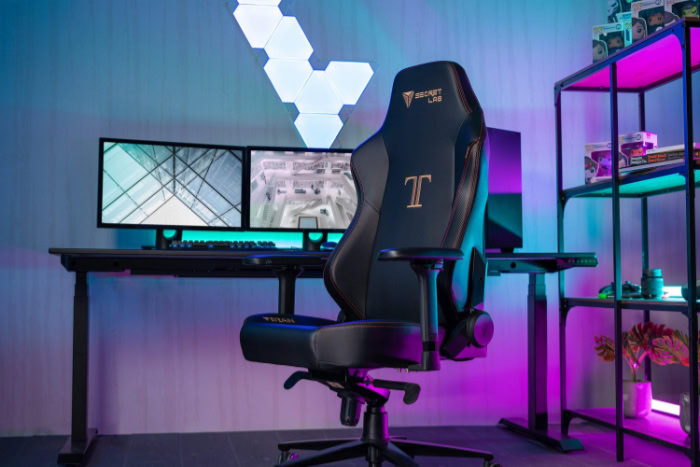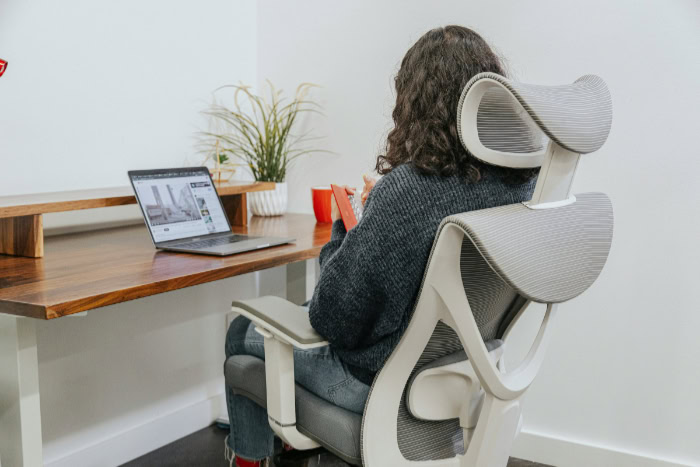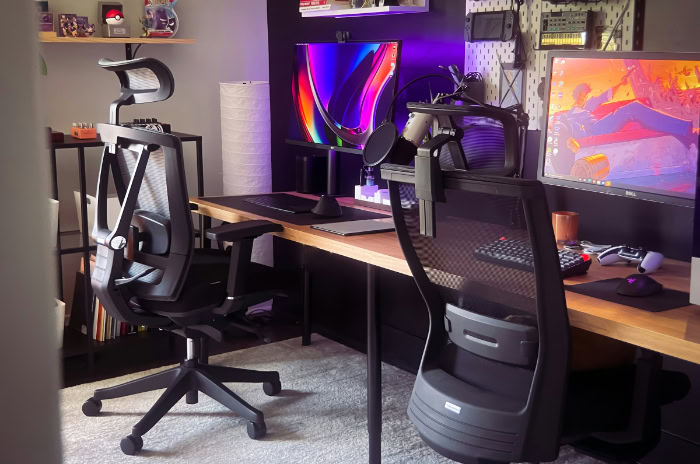Gaming Chair vs. Office Chair: What You Should Consider

The choice between gaming chairs and office chairs has sparked plenty of debate, and it’s easy to see why. Your chair isn’t just another piece of furniture, it’s a tool that directly impacts your comfort, posture, and ability to focus, especially during long hours of gaming or working.
With so many options available, it’s easy to feel overwhelmed when deciding which one better suits your lifestyle.
Gaming chairs bring bold designs and a sense of fun to the table, while office chairs focus on practicality and professional aesthetics. The real question isn’t which is better overall but which one aligns with your needs, environment, and habits.
Ergonomic Support and Health Impact
Choosing a chair that effectively supports your body is vital for maintaining good posture and minimizing strain during long hours of sitting. Both gaming chairs and office chairs are designed with ergonomics in mind, but their approaches to support and comfort differ significantly.
Posture Alignment
Posture plays a critical role in preventing back pain and muscle tension, so the way a chair encourages proper alignment is essential. Gaming chairs are often equipped with adjustable lumbar pillows and neck cushions, allowing users to customize support to their preferences.
The inclusion of a bucket-style seat and high backrest also helps maintain posture by cradling the body in a relatively upright position. However, the bucket seat design, inspired by car racing aesthetics, can feel restrictive for some, especially if the user shifts positions frequently.
On the other hand, office chairs take a different approach, prioritizing contoured backrests that naturally follow the curvature of the spine. Many models feature built-in dynamic lumbar support systems, which automatically adjust to your movements, ensuring consistent spinal alignment throughout the day.
The emphasis here is on promoting a neutral posture, helping to reduce the risk of slouching and encouraging a natural sit-stand motion when paired with adjustable desks.
Health Risks
While both chair types aim to reduce the strain of extended sitting, each comes with potential drawbacks if not used correctly. Gaming chairs, with their deep recline capabilities, are designed to support relaxed sitting postures.
However, prolonged reclining without proper lumbar and neck adjustments can lead to slouching, which places unnecessary pressure on the lower back and neck. Frequent gaming movements, such as leaning forward while focused, can also strain the shoulders and spine, especially in poorly adjusted setups.
Office chairs, in contrast, focus on encouraging an upright posture, which reduces spinal compression and allows the muscles in the back and abdomen to stay engaged. However, overly rigid models with limited adjustability can lead to discomfort, as they may not accommodate all body types or seating preferences.
A lack of adequate shoulder and upper back support may also leave individuals feeling fatigued after hours of sitting, especially in lower-priced or overly minimalistic designs.
Targeted Support
The type of support offered by gaming and office chairs often reflects their intended use cases. Gaming chairs are more likely to feature dedicated headrests and neck pillows, which are particularly beneficial for gamers who spend hours leaning back or transitioning between sitting and reclining positions.
These additions help alleviate tension in the neck and shoulders, making them ideal for users who alternate between active and passive postures.
By contrast, office chairs focus on delivering balanced support across the entire spine. Their ergonomic backrests and adjustable seat heights encourage a healthy seated position by aligning the hips, spine, and shoulders in a natural curve.
This focus on overall spinal alignment makes office chairs particularly effective for task-based work environments where the user remains seated for long periods without much movement.
Comfort and Adjustability for Extended Use

When sitting for long hours, comfort and adjustability directly impact how refreshed and focused you feel at the end of the day. Whether you’re gaming through the night or tackling an intense work schedule, the materials and adjustment options of your chair play an essential role in enhancing the sitting experience.
Padding and Materials
The materials and padding used in a chair greatly affect how it feels during prolonged use. Gaming chairs are typically built with thick foam padding that cushions the seat and backrest.
This padding creates a plush, firm feel, which can be appealing for those who enjoy a more supportive surface. Most gaming chairs are coated in synthetic leather (also known as PU leather), prized for its durability and sleek aesthetic.
While this material is easy to clean and holds up well to wear and tear, it can trap heat, making it less breathable during extended sessions, particularly in warmer environments.
Office chairs, on the other hand, often rely on more breathable materials such as mesh or fabric. Mesh backrests are especially popular for their ability to promote airflow, keeping the user cool and comfortable during long workdays.
Fabric-upholstered chairs offer a softer, more natural texture that many find inviting. The trade-off with these materials is that they may not feel as firm or luxurious as gaming chair padding and may show wear over time.
However, their focus on breathability and adaptability to temperature changes makes them better suited for individuals who sit for several hours without frequent breaks.
Customization Options
Adjustability is a defining feature when it comes to tailoring a chair to your specific needs. Gaming chairs are known for their extensive customization options, often including recline angles that go up to 180 degrees, allowing users to fully lie back for relaxation.
Many models also come with 4D armrests that can adjust in height, angle, width, and depth, giving users the flexibility to find the perfect arm support. Additionally, some gaming chairs offer adjustable seat depths, allowing users to modify the space between the edge of the seat and their knees for optimal blood circulation.
Office chairs, though often less flashy in their adjustability, focus on providing straightforward yet functional options. Height-adjustable seats, tilt tension controls, and recline locks help users find the right balance between support and flexibility.
While their recline range may be less extreme than that of gaming chairs, they often allow for a steady tilt that encourages micro-adjustments throughout the day, which can prevent stiffness. The simplicity of these adjustments makes office chairs easy to use, particularly in professional environments where reliability and consistency are valued.
Use Case Scenarios
The type of comfort a chair delivers often reflects its intended purpose. Gaming chairs cater to users who alternate between periods of intense focus and rest.
Their ability to recline deeply and their heavily cushioned design make them a good choice for activities that involve frequent movement or posture shifts, such as gaming or streaming. The added support for the neck and shoulders ensures that long gaming sessions are less taxing on the upper body.
Office chairs are designed with task-oriented sitting in mind, making them ideal for environments that require long hours of static, focused work. Their ergonomic shape and breathable materials are better suited for situations where maintaining an upright posture is important, such as typing, writing, or attending virtual meetings.
The emphasis on gentle, consistent support over long stretches of time helps reduce fatigue and ensures that users can remain productive without discomfort.
Design Aesthetics and Environmental Suitability

Choosing a chair is not just about comfort or support; its design and how well it fits into a particular setting are also important factors. Gaming chairs and office chairs cater to different visual preferences and environments, with each bringing its own appeal.
Visual Styles
The visual styles of gaming chairs differ greatly from those of office chairs, often reflecting the unique needs and personalities of their users. Gaming chairs are designed to stand out, featuring bold color combinations, racing-inspired silhouettes, and even RGB lighting in some models.
Bright reds, blues, and greens are common, and many chairs include logo placements, stitching accents, or themes based on popular games or esports teams. This makes them ideal for those who want their workspace to exude energy and a sense of fun.
Office chairs, on the other hand, lean toward understated elegance. Neutral tones such as black, gray, and white dominate their color palettes, while their shapes and lines are clean, modern, and functional.
Professional-looking finishes like polished aluminum or premium mesh elevate their appearance without drawing too much attention. The minimalist aesthetic of office chairs allows them to seamlessly blend into most corporate or home office settings, enhancing productivity without overwhelming the room’s decor.
Space Integration
The environment in which the chair will be used plays a significant role in determining which type is more suitable. Gaming chairs excel in personal or recreational spaces, such as gaming setups or streaming studios.
Their vibrant designs complement the tech-heavy, visually stimulating environments associated with gaming. They also serve as statement pieces, adding a sense of character and identity to a dedicated gaming area.
Office chairs, however, are built to integrate smoothly into professional workspaces or hybrid home offices. Their muted tones and compact profiles ensure they don’t dominate a room, making them well-suited for shared offices where subtlety is preferred.
For those with modern or minimalist work-from-home setups, an office chair’s ability to match a clean, organized aesthetic makes it a natural choice.
User Perception
The design of a chair can also have a subtle but meaningful impact on how users perceive their environment and roles. Gaming chairs, with their bold aesthetics and immersive features, are often seen as tools for enjoyment and leisure.
Their design encourages users to relax and recharge, making them a great fit for gaming marathons or recreational activities that don’t demand a strict focus on productivity.
Office chairs, in contrast, embody professionalism and structure. Their ergonomic and polished appearance signals an intention to get work done, which can help users mentally shift into a productive mindset.
In environments where efficiency and focus are priorities, the clean and neutral aesthetic of an office chair can foster a sense of discipline and organization.
Cost vs. Long-Term Value

Cost is often one of the most important considerations when selecting a chair, but it’s equally vital to think about the long-term value it can provide. Gaming chairs and office chairs span a wide price range, with premium models sometimes overlapping, yet their durability and purpose often dictate how much use and satisfaction you’ll get over time.
Price Range
The cost of gaming chairs and office chairs varies significantly depending on their build quality, design features, and brand reputation. Mid-tier gaming chairs are generally priced between $200 and $500, offering features like recline options, thicker padding, and adjustable armrests.
Budget options are available for under $200; however, they may sacrifice build quality and material longevity. On the higher end of the market, premium gaming chairs can exceed $800 and typically feature more durable materials, advanced ergonomics, and design upgrades, such as luxury leather finishes or memory foam padding.
Office chairs, meanwhile, cater to an even broader spectrum of price points. Budget-friendly models can start at $100 and extend up to $300, providing simple but effective ergonomic designs.
In the premium category, office chairs that exceed $800 are often regarded as investments due to their superior adjustability, durable materials, and exceptional comfort for extended sitting. Examples include models designed with highly adaptable lumbar systems and industrial-grade components, which justify their steeper price tags.
While there is overlap in pricing for high-end gaming and office chairs, their differences in design focus and intended use remain clear.
Durability Factors
Durability plays a key role in determining how long a chair will last, especially for those who use it daily. Gaming chairs are known for their sturdy steel or aluminum frames, ensuring a solid build that can hold up under regular use.
However, one common drawback is the use of synthetic leather as upholstery, which, while resistant to wear in the short term, tends to peel or crack after prolonged exposure to heat and friction. Over time, highly cushioned seats may also lose their firmness, affecting overall support.
Office chairs tend to offer a more balanced approach to durability. Mesh-backed models, for instance, are highly breathable and maintain their elasticity well over the years, though they can weaken if stretched excessively.
Fabric-upholstered options are more resistant to peeling compared to synthetic leather, but the foam beneath the upholstery may compress over time, reducing comfort. While high-quality office chairs often incorporate reinforced materials designed to withstand years of use, budget models may lack the same long-term resilience.
Return on Investment
The value a chair provides depends largely on how it aligns with the user’s primary needs and how well it supports daily habits. For individuals who spend long hours gaming, a chair with adjustable recline angles, robust padding, and neck and lumbar pillows might be worth the cost, as it can enhance comfort during marathon sessions.
However, the lower durability of materials like synthetic leather may make frequent replacements necessary, which might outweigh the initial savings of a budget or mid-tier gaming chair.
Office chairs, particularly those with high-end ergonomic features, are often designed for consistent use over prolonged workdays, making them a strong choice for productivity. The emphasis on balanced support and adjustability ensures that they can accommodate a wide variety of sitting postures, reducing discomfort and fatigue.
While premium office chairs require a significant upfront investment, their durability and functionality tend to result in better long-term value for professionals seeking consistent comfort and support over eight-hour workdays or more.
Budget-conscious buyers must weigh their priorities carefully. Those who prioritize aesthetics and versatility may find gaming chairs more appealing, whereas those looking for durability and ergonomic precision may lean toward office chairs.
Ultimately, the return on investment boils down to the chair’s ability to meet lifestyle demands while maintaining its quality over years of use.
Conclusion
Both gaming chairs and office chairs bring unique advantages to the table, with their designs tailored to distinct needs and preferences. Gaming chairs excel in aesthetics, customizability, and features that cater to dynamic, movement-rich activities like gaming or streaming.
They are often more visually striking, offering bold designs and a sense of immersion, but their synthetic materials and recline-focused ergonomics may not suit all users for extended, static sitting.
Office chairs, in contrast, prioritize functionality, ergonomic support, and seamless integration into professional or hybrid workspaces. Their minimalist designs, breathable materials, and balanced spinal alignment make them perfect for long hours of productivity.
However, compared to gaming chairs, they may lack the flair and adjustable features valued in more relaxed or versatility-driven settings.
The right choice ultimately depends on your dominant use case. A gaming chair may be the better fit for those who prioritize leisure, style, or flexibility in posture, while an office chair is ideal for task-focused work environments or all-day sitting.
For a hybrid lifestyle, balancing gaming and work, it’s worth considering a chair that blends the ergonomic features of office chairs with the stylistic appeal of gaming models.


